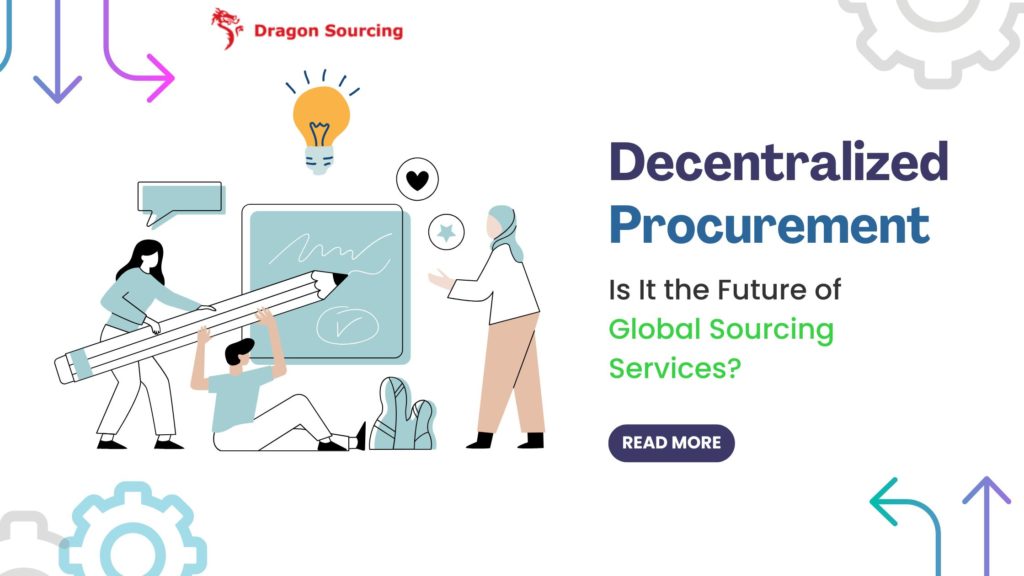
Summary:
-
Decentralized procurement empowers departments to manage their own purchasing, offering greater flexibility and faster decision-making.
-
It strengthens local supplier relationships and encourages innovation tailored to specific business unit needs.
-
Challenges include lack of standardization, missed bulk discounts, and data silos.
-
A comparative table shows key differences between centralized and decentralized models.
-
Technologies like AI, cloud platforms, and blockchain help overcome decentralization issues.
-
Many firms are adopting a hybrid model for strategic control with local agility.
-
Decentralized procurement is increasingly seen as the future of global sourcing services in 2025.
The intense pressures of today’s global marketplace are putting procurement strategies in the spotlight. The conventional centralized procurement model, known for its consolidated control and uniform processes, is increasingly being contrasted with the decentralized approach, which emphasizes agility and responsiveness. As companies grapple with complex supply networks and volatile markets, a key question emerges: Will decentralized procurement become the dominant model for global sourcing services?
Understanding Decentralized Procurement
Decentralized procurement refers to a system where individual departments or business units within an organization have the autonomy to manage their purchasing activities. This contrasts with centralized procurement, where a single department oversees all purchasing decisions.
Advantages of Decentralized Procurement
1. Enhanced Flexibility and Responsiveness
Decentralized procurement allows local units to make swift decisions tailored to their specific needs, leading to increased agility in responding to market changes.
2. Improved Supplier Relationships
Local procurement teams can foster stronger relationships with regional suppliers, leading to better communication and potentially more favorable terms.
3. Customization and Innovation
Departments can source products and services that align closely with their unique requirements, fostering innovation and efficiency.
Challenges of Decentralized Procurement
1. Lack of Standardization
With multiple units operating independently, maintaining consistent procurement processes and standards can be challenging.
2. Reduced Economies of Scale
Decentralized purchasing may miss out on bulk discounts and consolidated supplier agreements, potentially leading to higher costs.
3. Data Silos and Compliance Issues
Disparate systems can result in fragmented data, making it difficult to monitor spending and ensure compliance across the organization.
Comparative Analysis: Centralized vs. Decentralized Procurement
| Aspect | Centralized Procurement | Decentralized Procurement |
|---|---|---|
| Decision-Making | Central authority | Individual departments |
| Flexibility | Limited | High |
| Supplier Relationships | Broad, less personal | Localized, more personal |
| Economies of Scale | High | Low |
| Process Standardization | Uniform | Varied |
| Data Management | Consolidated | Fragmented |
The Role of Technology in Decentralized Procurement
Advancements in technology are mitigating many challenges associated with decentralized procurement:
-
AI and Predictive Analytics: These tools enable departments to forecast demand accurately and make informed purchasing decisions.
-
Cloud-Based Platforms: They facilitate real-time data sharing and collaboration across departments, enhancing transparency and control.
-
Blockchain Technology: By providing a secure and transparent ledger, blockchain ensures the integrity of transactions and supplier compliance.
Decentralized Procurement in Practice
Many organizations are adopting a hybrid procurement model, combining centralized oversight with decentralized execution. This model leverages the benefits of both systems, allowing for strategic alignment and local responsiveness. Businesses that succeed in integrating real-time communication, shared digital infrastructure, and data analytics into a decentralized framework can gain a powerful edge in their global sourcing operations.
Conclusion
Decentralized procurement offers significant advantages in terms of flexibility, responsiveness, and localized decision-making. However, it also presents challenges that organizations must address through robust processes and technological integration. As global sourcing becomes increasingly complex and nuanced, a hybrid procurement model that balances central control with decentralized execution may emerge as the optimal strategy for many businesses.
By embracing digital tools, fostering cross-functional collaboration, and ensuring transparency across units, global sourcing service providers can position themselves for sustained success in 2025 and beyond.
References
-
Art of Procurement – Procurement Operating Models
https://artofprocurement.com/blog/procurement-operating-models -
Pipefy – Centralized vs Decentralized Purchasing
https://www.pipefy.com/blog/centralized-decentralized-purchasing -
ZipHQ – Centralized vs Decentralized Procurement
https://ziphq.com/blog/what-is-the-difference-between-centralized-and-decentralized-procurement -
Spendflo – Top 10 Procurement Trends for 2024
https://www.spendflo.com/blog/top-10-procurement-trends-for-2024 -
Groves & Company – 2025 Procurement Technology Predictions
https://grovesandcompany.com/looking-ahead-2025-procurement-technology-predictions



